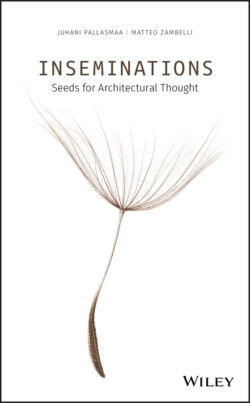Читать книгу Inseminations - Juhani Pallasmaa - Страница 45
Infinity and Limits: Infinitude, Eternity and Artistic Imagination (2017)
ОглавлениеIn Renaissance time, architecture aspired to mediate between the worlds of gods and mortals, and aimed at giving the act of building a new authority by giving it a mathematical grounding. ‘The belief in the correspondence of macrocosm and microcosm, in the harmonic structure of the universe, in the comprehension of God through the mathematical symbols of center, circle and sphere ‐ all these closely related ideas which had their roots in antiquity, and belonged to the undisputed tenets of medieval philosophy and theology, acquired new life in the Renaissance’.47 ‘There was an unbroken tradition coming down from antiquity according to which arithmetics (the study of numbers), geometry (the study of spatial relationships), astronomy (the study of motions of celestial bodies), and music (the study of motions apprehended by the ear), formed the quadrivium of the “mathematical arts”. By contrast to these, the “liberal arts” of painting, sculpture and architecture, were regarded as manual occupations’,48 Rudolf Wittkower informs us. In order to raise architecture from the level of a mechanical to that of a mathematical art, it had to be given a firm theoretical, i.e. mathematical foundation, and that was to be found in musical theory based on the studies of the Greek geometrician Pythagoras.
The relationships and interactions of science and art are still an ongoing issue. Science is usually judged to have a higher truth value, but there are voices that see the meaning of art being closer to lived human reality. Vittorio Gallese, one of the four discoverers of the mirror neurons 30 years ago, which have opened exciting views into our unconscious interactions with the world, expresses an unexpected view of the relationship between science and art: ‘From a certain point of view, art is more powerful than science. With much less expensive tools and with greater power of synthesis, artistic intuitions show us who we are, probably in a more exhaustive way with respect to the objectifying approach of the natural sciences. Being human squares with the ability to ask ourselves who we are. Since the beginning of mankind, artistic creativity has expressed such ability in its purest and highest form’, Gallese writes.49
Certain modern and contemporary artists, especially of the conceptual orientation, have produced purely cerebral artistic works, that rely more on thought processes and intellect than sensory perceptions and emotive identifications, approaching thus the realm of science. The work of the Islandic‐Danish artist Olafur Eliasson is frequently suspended between the realms of science and art. Usually, his works have a meticulously considered scientific ground, based on a theoretical knowledge of physics and perceptual psychology. This background gives rise to his perfectly executed technical constructions, which lead the viewer to personal sensory observations and, often unnoticeably, also from the realm of objectivity into that of the subjective. Frequently the experiences have the nature of miracle or magic. The viewer's experiences are evident and clear at the same time that they are enigmatic and unbelievable. The dual character of the works as unmasked scientific experiments and emotive confrontations usually creates a feeling of a phenomenon that is beyond the boundaries of normality. Eliasson's atmospheric installation in the immense Turbine Hall at the Tate Modern in London, entitled The Weather Project (2003), created the authority of real sunlight, that encouraged visitors to lie down on the concrete floor as if they were sunbathing on a beach.
Altogether, there are three categories of giving human meaning to our being‐in‐the‐world: religion (or myth), science and art. The first is based in belief and faith, the second on rationality and knowledge, and the third on emotion and experience. Eliasson's works usually fuse or short‐circuit the categories of science and art, and give rise to a sublime experience, which can even invoke religious forebodings. While many of his works project sublime experiences, they can also reverse or contradict the viewer's expectations. In a concrete perceptual sense, his mirror works create infinitely repeating spaces or endless perspectival corridors. In his installation at the Louisiana Museum in Copenhagen, the modernist white interior of the Museum was turned into a landscape of rocks, gravel and water, reversing time as if the landscape that existed there before the construction of the museum had taken over. His works in the Bregenz Museum, designed by Peter Zumthor, turned the white minimalist museum interiors into landscapes of water, water plants and fog – the man‐made architectural space turns into a jungle.
The relationship of reality and art is not as simple and self‐evident as we might think. ‘Nothing is more abstract than reality’, Giorgio Morandi states thought-provokingly,50 while another great artist, Alberto Giacometti gives another advice on the problematic relationship of reality and art: ‘The object of art is not to reproduce reality, but to create a reality of the same intensity’.51 Neither does science reproduce reality, it reveals its inner structure.
